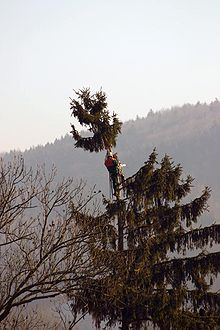Tops
The top of a tree is called a tree top or plait , crown , or tree crown . It forms from the end of the trunk and is usually still provided with twigs, branches and leaves or needles. The wood of the top area is called plait wood . It is not to be confused with the braid piece .
Etymology and usage
In Grimm's dictionary , the top is described as the upper, swaying part, moving tip of plants, especially trees, in contrast to the more solid woody parts such as trunk, branches, stems . The main meaning is already attested in Old High German as the moving upper part of a tree. It is based on the Middle High German verb wipfen in the sense of moving swinging, jumping , which is later found in the seesaw .
Tops
As tops in the fruit and forestry, the knocking of Wipfels is called a tree. The purpose is to sprout young wood. Fruit trees that are almost on the verge of going out get new strength and become fertile again. The currently preferred rejuvenation pruning in fruit trees avoids simply cutting the upper crown. The trees, which tend to become old , are also shortened, but the cuts are made more gently and with the derivation on more suitable branches large, very poorly healing wounds are avoided, the rejuvenation cut takes place in the entire treetop.
Historically, the top of the tree is the origin of the Christmas tree : The fir tree in particular was topped in the 19th century in order to raise it to a strong trunk. The resulting, well-formed and thick braids were then reused.
See also
- Tree top path
- The village in the air (a settlement in the tops of the trees)
- Rope-assisted tree climbing technology Chapter: Removal of the top
Web links
- To use summit versus treetop on zeno.org.
Individual evidence
- ↑ Bernd Wittchen, Elmar Josten, Thomas Reiche: Holzfachkunde. 4th edition, Teubner, 2006, ISBN 978-3-519-35911-1 , p. 99.
- ↑ The dictionary of origin. The etymology of the German language. Vol. 7, 1963, ISBN 978-3-411-00907-7 (reprint), p. 767.
- ↑ Economic Encyclopedia . by JG Krünitz Keyword: treetops

